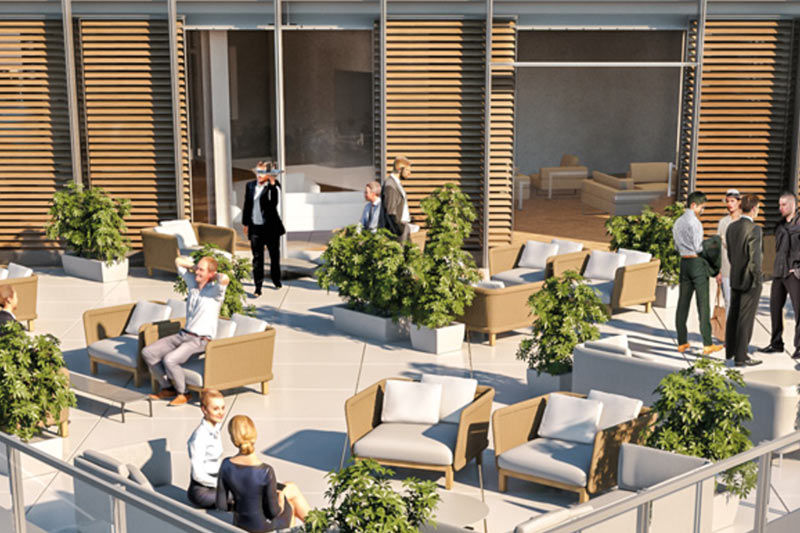However, any assessment of a building’s sustainability must be based on shared, recognisable and measurable criteria. Since 2000, PSP has also been working in line with the best practices established by EPRA (European Public Real Estate Association), a non-profit organisation which has put together consistent, transparent guidelines for assessing and reporting on property developments.
“This is an activity that allows us to draw up very well-structured reports which provide a clear picture of the efforts made by each company, all without transcribing the data with coefficients which, at the end of the day, nobody expects. For us, as we were already following these principles, it is first and foremost an effective means of communicating with our investors in a direct, transparent way. That is an advantage which, by its very nature, allows us to make our communication more transparent and sustainable”.
A timely move, given that the development of a shared reporting and assessment system on the impact of production activities on the environment was one of the main agreements reached at the end of COP26. These also include demands for a renewed commitment from high-emissions sectors.
With regard to this, Gabriel emphasises that “real estate can have a decisive influence on the liveability of cities. It is certainly much easier for investors who have vast amounts of space at their disposal, given that they can brand them with a well-defined character and reap the benefits of the advantages that they create. However, in our experience, it has often emerged that, by compromising on certain floor area ratios for the building - for example, in terms of volume - it is possible to improve the quality of a neighbourhood to the benefit of both the residents in the immediate vicinity and the project area as a whole, even - perhaps less predictably - providing an economic benefit”.
Quality, then, rather than quantity, becomes a crucial value to be leveraged here.
Luciano Gabriel continues: “there are many properties which, after a regeneration that has taken up much less space, have proven to be more profitable, in part because of the improved liveability of the area. This is what we have seen in a number of cases, although it must be said that unfortunately, most real estate representatives have a somewhat limited way of thinking and as such, opt to maximise the square metreage of net usable area without considering the complementary effect that the liveability of the local area can have, which also has a positive influence on the economic aspect”.
It is for precisely this reason that the COP26 event and the debates underpinning it must be considered starting points rather than end points. “At the highest levels, everyone agrees on the principles of sustainability. When discussing it at the global level, the issue is very simple, and we could say the same about the European or national levels. The problem really arises when you have to translate these ideas into specific operations at the local level. Specific decisions ultimately result in specific problems”.
See also: Real estate looks to the future
By assigning new responsibilities and expressing new expectations of the real estate sector, Luciano Gabriel believes that it is now time for market players to take on their share of the burden too.
“As expressed at the conference, it is important for the government to take care of infrastructure and not overextend its reach, for example by offering direct subsidies to investors, because this can create misguided incentives and lead private resources to focus on seeking out funding rather than on the operations themselves”.
In this way, by creating the conditions for the market to develop and consolidate itself under its own steam, driven by its most forward-thinking players, it will be possible to make sustainability a fundamental asset of any and every property development project: “this is by no means a new approach. What we have seen, including in other countries, is that if the infrastructure works (and I am referring specifically, on the urban scale, to railways and public transportation links), then the investments will naturally follow. And the private sector is much more dynamic, innovative and aware of energy issues than politicians often imagine it to be”.
In a year’s time, the countries of the world will meet once again to discuss climate change at COP27, which will be held in Egypt. For many representatives of the real estate sector, this will be an opportunity to demonstrate their commitment and the initiatives they have undertaken to respond to the demands that came out of Glasgow in terms of reducing their carbon footprint, adopting new technologies to improve the liveability of the spaces they design and stimulate conscious behaviour and lifestyles, and participating in the creation of a circular economy.
However, any new regulations and directives must go hand in hand with a concrete and realistic mechanism to ensure their feasibility, specifically one which can keep the sector competitive and also generate value for investors.
On the closing agreements of COP26, Luciano Gabriel concludes: “I would advise thinking long and hard about the operational and executive side of the ideas being proposed, because at a general level, everything seems much easier, but then when it comes to working on the project itself, defining the financial structures and expected returns, conflicts are sure to emerge. So those proposing these ideas need to be much more aware of the practical side of them”.
It is only with these principles that in a year’s time, the real estate sector will be able to present itself as one of the most conscious, committed and proactive sectors in the fight against climate change.





